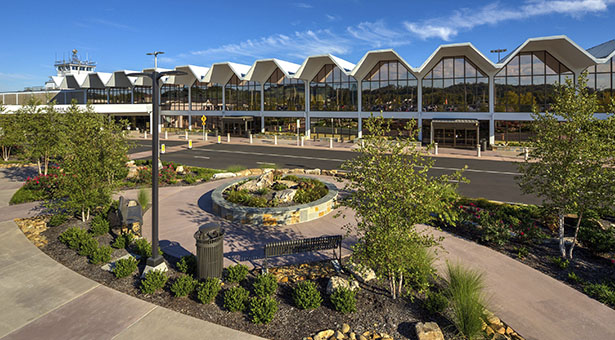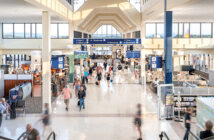By Scott Robertson
It’s 10 a.m. Monday at Tri-Cities Airport in Blountville. The parking lot is virtually empty, save for overflow of rental cars nobody’s renting. The three TSA agents estimate they’ve allowed around a half-dozen travelers to the gates this morning. The gift shop closed a few days ago with no pre-determined re-open date. And, upstairs in the conference room, the airport management staff is gathered, though not too closely together, hosting a zoom meeting of the Airport Authority Board Executive Committee.
“There’s been no (Coronavirus) exposure we know of with staff here at the airport,” Airport Director Gene Cossey tells the committee. The airport has only one employee who is currently self-isolating, and that employee, having found out they were possibly in contact with someone who was infected over a weekend, did not return to work at the airport, instead notifying the facility remotely and staying home.
Nonetheless, cleaning all surfaces has become a high priority at the airport. Allegiant ticket counter workers who have no flights to work are being put to work in custodial roles as the crisis continues.
“We’re doing that for two reasons,” Cossey says. “As much as we can, we don’t want to send people to the unemployment office, and we also think the extra help with maintenance and cleaning is both good for the upkeep of the airport but also to keep the disease from spreading as much as possible.”
Airport open, “no matter what”
Regional residents worried that the airport might go out of business during an extended crisis have nothing to fear, Cossey says. “We have all of our federal obligations to continue to operate no matter what the actual air traffic situation is.”
To that end, the federal government is easing some requirements to facilitate operations, Cossey says. “They (the FAA) are not sending out inspectors until hopefully this is done. They’re still figuring that we’ll be within a year (since the last inspection) but they’ve also indicated that if this continues and they don’t get within those one-year requirements, they’ll re-adjust that situation.”
If the TSA numbers are any indication, the actual air traffic situation is about as bleak as it can get. “TSA has a report we got from our air service consultant,” Cossey says. “For the last few days, where the TSA were screening 2.2 million people at this time last year, this year it’s 136,000. I can’t even understand what places like Atlanta look like with that few people going in and out.
“But what we’re hearing is that a complete shutdown is not likely, nor do we expect the FAA or the government will tell the airlines to stop flying and shut down the airspace. Air travel is critical to our security and safety in the United States. Doctors have to be able to travel. Cargo has to ship. So, we expect that we will continue to have to meet our federal obligations and keep the airport open.”
Current operations, such as they are
The airport has pulled all its advertising, with the exception of that placed on the expedia website, says Director of Marketing and Air Service Development Kristi Haulsee. “We just felt it wasn’t appropriate to be advertising air travel at this time. We stayed on expedia simply because people go there to actually book trips.”
The airport pulled all content related to air travel from its social media feeds. “We’re focused on COVID and the things people need to be doing, the health aspects such as washing hands and not going out if you don’t need to. We’ve also been doing some shares from our airline partners.”
The airlines and ad media aren’t the only ones feeling the economic pressure, Cossey says. The airport’s other business functions are barely functioning.
“We have almost no cars out in the parking lot, which of course is one of our huge revenue streams. The (auto rental vendors) are continuing to operate. They’re just on a very low staff. They’re using some of our parking area for overflow cars because obviously they have very few cars on the road right now.” A few rental car companies have asked other airports to waive their rents and fees. “What we will do is defer rent for them if they’re in a position where they just can’t pay us,” Cossey says. “But the FAA has concurred that we can’t just waive all their fees, even in a situation like this. That has to do with revenue diversion and the different laws governing airports. Most of us have just been acknowledging those requests but not really responding to them.”
The Tailwinds food and drink concession has closed at the airport. Vending machines have been installed in the gate area. “Obviously with 85 percent of our passengers being gone, they were selling very little. When we were down 75 percent they were only selling $40 to $50 a day. That wasn’t enough to continue operations.”
Finances through fiscal Q4
Before the coronavirus crisis hit, Tri-Cities Airport was on a pace to increase passenger traffic by a significant amount over the previous year. That fact will help the airport coast to the finish line of the current fiscal year despite what Cossey describes as a “huge decline” since the crisis began.
In analyzing the possibilities for the rest of fiscal 2020, Director of Finance Rene Weber began by deleting two months from the revenue stream of traffic-affected revenue accounts, including landing fees, terminal space rental, general aviation costs and fuel flow. “An analysis indicates that we lose about $350,000 per month just from those air-traffic-sensitive accounts. That is about 60 percent of our revenues.”
That presents the airport with a small operating loss for fiscal year 2020. “I should add that through February of 2020, we were up significantly,” Weber adds. “Our traffic through February, which was eight months ended, had a 12.8 percent increase. So, we’re going down into the valley now, but at least we were on top of the hill when we started the downward roll.”
Finances in fiscal 2021
The budget for fiscal 2021 will have to be a “living document,” Cossey tells the committee. “The future is very fuzzy right now as far as where things are going for our airport. There is no way to tell over the next six to 12 months how things are going to go.”
Weber says, “From a budget standpoint for 2021, obviously we don’t have some of the tools we normally use for our budgeting process, which includes the rates and charges model which actually spins off from the proposed flight schedules.”
So, Weber has made assumptions in an effort to create a mid-range budgetary scenario which is neither best- nor worst-case. The working budget is based on a model in which the pandemic ends before the end of the fiscal year, June 30, 2020. Weber also went back to the 2019 results that were used to create the 2020 budget. “We will continue to work on the budget and try to get it back in line by analyzing our expenses and the compensation program we’ve proposed,” he says. “But at this point, absent any significant information as to what flight schedules are being proposed beginning July 1, 2020, it’s simply a little bit too much of a reach to give a budget that we could place any reliance on.”
The good news is the airport expects to receive somewhere north of $1 million from the CARES Act, which will hardly begin to offset the revenue losses, but will help carry the airport along on a cash-flow basis.
Based on the assumptions that were necessary to begin the budgeting process, Cossey says he feels the airport can operate through December on the cash flow, even without the CARES Act money being taken into account. “The problem is, we don’t know how accurate those assumptions are going to be as time goes forward.”
For instance, flight schedules are a far-away moving target. Currently, most airlines are leaving their existing schedules in place, but are cancelling around half the scheduled flights. “It’s not that they’re not trying,” Cossey says of the airlines. “It’s just trying to figure out the impact this is having to their whole network. It’s not just, ‘What’s the schedule at Tri-Cities?’ It’s what’s the schedule in the whole network they run and how does one domino hit the next domino. Trying to get that schedule for them is a nightmare.”
Predicting how the dominos will fall in 2021 will be only the beginning of how to come back from the current crisis, Cossey says. For at least the next year, airport management will have to be nimble enough to move their own fiscal dominos in time.
“We will try to come up with the most accurate budget we can for 2021 in June and we’ll get that approved at the June board meeting, but again, we’re just going to have to be prepared for all kinds of different possibilities and be very adaptive on almost a month-to-month basis.”




